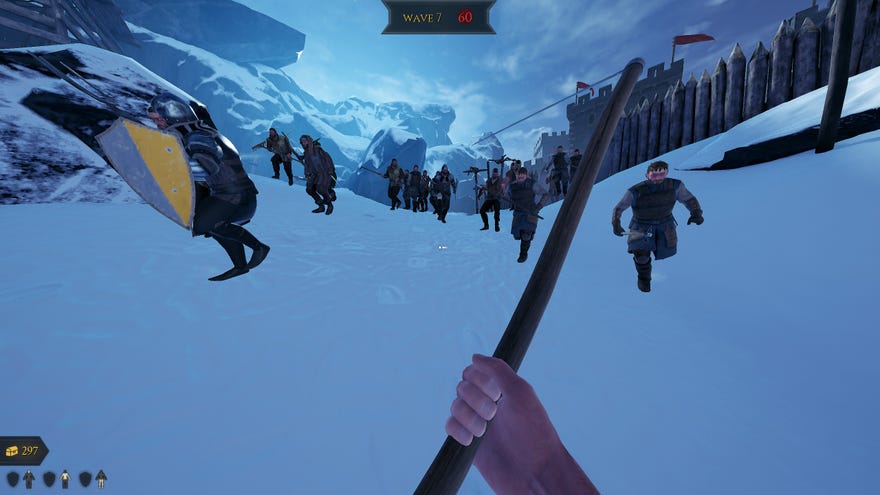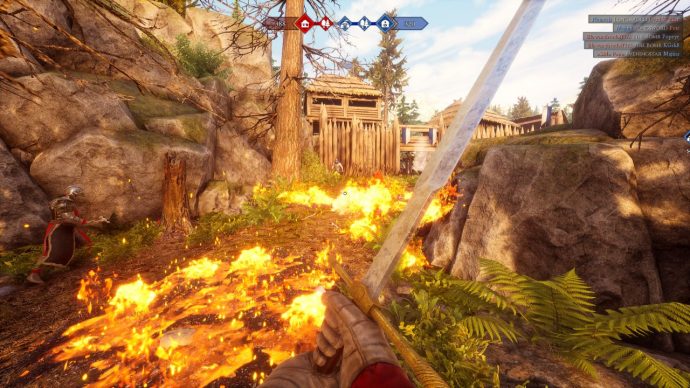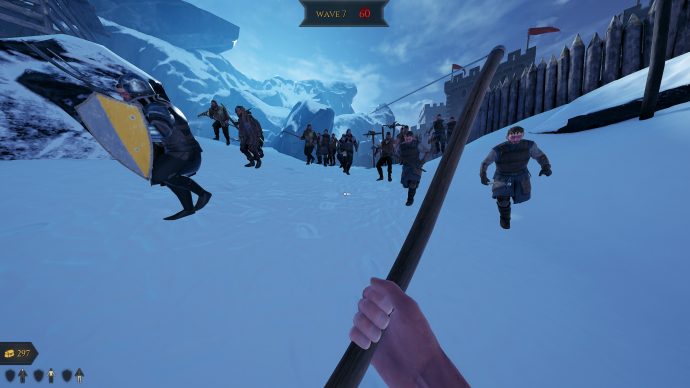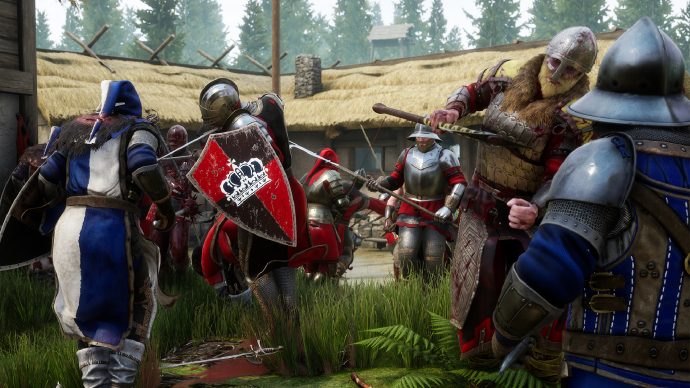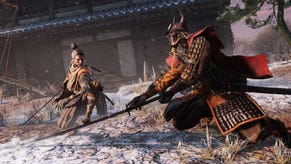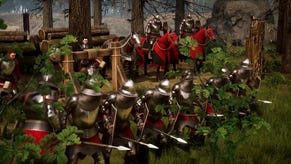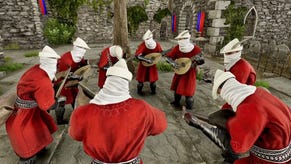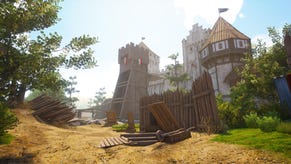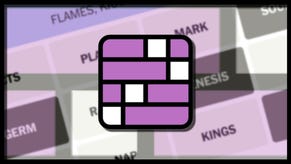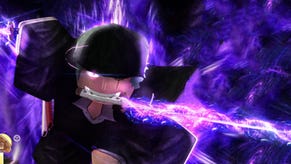Mordhau game modes - explanations and tips for Frontline, Skirmish, Horde, and Duel Servers
FOR THE HORDE
I spent a great many dozens of hours figuring out how to play Mordhau before I first tried Horde Mode. I'd got to the point where I would consistently rank at the top of the leaderboards on Frontline, Team Deathmatch, Duel servers... but when I first played Horde, I was completely lost. I died on Wave 4, after being pinned against a stone wall with a dozen hairy bare-chested peasants kicking me over and over until I fell.
I say all this as a warning: don't expect to be able to use the same style of play in every one of Mordhau's game modes. Instead, why not take a look online at some sort of guide to describe every different game mode, or something... Oh, you've done that part already? That's why you're here? Well then! This Mordhau game modes guide will walk you through each different mode available in this beautiful medieval decapitate-'em-up, with tips on how to adjust your style of play to ensure you play each one to the best of your ability.
And while you're here, why not check out our main Mordhau guide, which is packed with beginner's explanations and advanced tips - not to mention links to other areas of our guide series, from Mordhau weapons and stats to the most powerful Mordhau builds/loadouts, and much more.
Mordhau game modes guide
There are a total of six official game modes in Mordhau, and a seventh unofficial mode. That means we've got a fair amount to cover here, so feel free to use the links just below to skip ahead to the section of your interest.
| Frontline | Battle Royale | Horde | Skirmish |
| Deathmatch | Team Deathmatch | Duel Servers |
Frontline
Frontline is, for all intents and purposes, Mordhau's flagship game mode. In this mode - which will incidentally be very familiar to those of you who came from Chivalry back in the day - involves two teams (Iron Company and Free Guards) of up to 32 players each fighting along a series of capturable checkpoints in a tug-of-war style. Each team begins with 1000 points (always visible at the top of your screen), and the aim is to deplete the opposing team's points to zero. There are three methods by which to accomplish this noble goal:
- Killing an enemy depletes their team's points by 1.
- Capturing the central checkpoint causes the enemy team's points to slowly diminish over time.
- Finishing the game by completing a certain objective specific to the map will instantly deplete your enemy team's points to zero.
There are also certain objectives which must be carried out during a game depending on the map you're fighting on. In Camp, for example, before they can capture the Free Guards' second checkpoint the Iron Company must escort a cart to that checkpoint by standing nearby in order to move it along. In Grad, the Iron Company must tear down barricades preventing them from accessing the Free Guards' castle interior.
Frontline is often a very hectic and large-scale affair, and you'll need to pay attention to your surroundings to make sure you're not isolated from your teammates and overwhelmed by superior numbers. You should also never forget the true focus of Frontline - not necessarily to kill as much as possible, but to capture checkpoints and complete objectives. You can fell 100 enemies without losing a single life, but if the enemy has captured the central checkpoint the whole time you've been killing, your team is still likely to lose.
Battle Royale
Mordhau's Battle Royale mode takes a lot of cues from the BR genre in general; it's a free-for-all mode which drops you and up to 63 other players into the same map with nothing but your fists, while an ever-shrinking ring forces you all closer and closer together until just one player is left standing.
Another similarity Mordhau's Battle Royale mode shares with its namesake genre is that success depends largely on the loot you find. There are chests and various gear scattered about the map, and your number one priority must always be to get your hands on any kind of weapon as quickly as possible, or you'll last seconds instead of minutes as you try to block the incoming Bardiche strike with your bare fists.
Of course, depending on your relative skill, you can overcome the disadvantages of inferior gear. I once spawned next to a chest with nothing but a Carving Knife, while my nearest opponent spawned next to a Zweihander and beelined straight towards me. Thankfully, my barrage of super-fast combos and morphs, coupled with a few well-timed parries and chambers, allowed me to prise that Zweihander from my opponent's cold dead hands. So it's not all down to the loot you find at the start of a match - though it can feel like it sometimes.
A third similarity with other BRs is that, once you're equipped with a weapon and armour and you're able to fight and kill other players, your biggest weakness will always be the approach of a third party while you're fighting. To this end, it's very important to keep your head on a swivel even as you fight, because the map isn't that big and there will always be other players about. To this end, it's very useful to have a good striking weapon equipped, such as a Zweihander, Executioner's Sword, War Axe, and so on - and make use of drags and accels to be constantly looking about your surroundings even while you land blows on your enemy.
For more detailed tips and tricks on dominating Mordhau's battle royale mode, be sure to check out our Mordhau Battle Royale guide.
Horde
Horde Mode is a wildly different experience than any of the other game modes in Mordhau, as there's no PvP combat here. Instead, as a team or alone you must work to overcome increasingly difficult waves of AI enemies, starting with no weapons or gear but earning gold over time in order to purchase various weapons, Armour, and throwables scattered about the map.
You don't heal normally in Horde Mode until the current wave is defeated; however, killing enemies will replenish some of your Health. If you die, then you cannot respawn until your team defeats the current wave of enemies; and if your entire team is defeated, then the game ends there. There are in total 21 waves of increasingly difficult enemies, both in quantity and in quality. And be warned up-front: this is an extremely difficult mode to try alone or in smaller groups, no matter your skill level.
There are some ways to "cheese" your way through Horde Mode where you rush ranged weaponry and then camp areas that the majority of enemies can't reach (i.e. where the only way up is a stepladder which apparently forces the AI to rethink all their life decisions up to this point). But I'd discourage these types of strategies because not only is it not in the spirit of the game, it's also deadly dull.
Your aim here should almost always be to rush the Scythe, which costs 90 gold to purchase. Many of the AI enemies early on have trouble with blocking incoming strikes, and the Scythe allows you to tear through multiple unarmoured enemies at once with every hit. As time goes on you should look to upgrade your armour first with a chestplate and then a helmet and finally legs. You'll also want to switch your Scythe for something like a Zweihander once you get the money, because the Scythe's thrusts are significantly weaker than its strikes and will eventually let you down.
Besides steadily increasing the quality of your gear, the other golden rule of surviving Horde Mode is to have a good knowledge of each map - not only so you know where all the valuable gear can be found and purchased, but also because you'll spend much of your time backing away from the enemy hordes, and if you need to have excellent spacial awareness in order to avoid ever getting backed up into a tight spot. But if you do end up getting surrounded or cornered, don't panic. You have a short time where you can still escape, and the way you do this is by blocking an incoming attack in order to riposte into another enemy, who will hopefully die or be knocked back just enough for you to escape.
Skirmish
Skirmish is an interesting team mode which, due to its format, leaves players much more wary and survival-focused than any other mode. The reason for this is that Skirmish pits two teams against one another in a series of last-team-standing rounds, where if you die, you don't respawn until the current round ends. Depending on the size of these matches, this means if you die early you can end up spending a lot of time as a spectator rather than a fighter.
On the flipside of this, I find there's a lot of satisfaction to be gained from surviving and performing well in a game mode where dying actually matters. At can also make for some very intense stand-offs and comeback stories. A Skirmish match only ends once one team wins 7 rounds (on official servers, at least). Once or twice I've been part of Skirmish matches that reached 6-6, and let me tell you, the tension was always so palpable you could beat an enemy round the head with it.
Here more than any other game mode, there's an emphasis on sticking with your team. On maps like Mountain Peak, where there are three defined paths towards the enemy (left, right, centre), often your forces will be split up randomly between these paths, and whoever happens to send the most men down a particular path will often win. If you want to survive, it's best only to pick a fight when you have at least a couple of teammates alongside you.
Deathmatch
Deathmatch is your standard free-for-all. Taking place on smaller, more cordoned off areas of the larger maps, it's by far the simplest of all the game modes in terms of your goal: kill as many other players as possible while staying alive as much as possible. The game ends when one player reaches a certain number of points, which on official Deathmatch servers is the equivalent of 30 kills. If the time limit expires before any player reaches this number, then the player with the highest number of kills wins.
Something to bear in mind is that your deaths don't actually factor into your score (not unless you kill yourself), which means you shouldn't feel dismay at dying all the time. It's kind of agiven in larger Deathmatch games, and all that matters is your number of kills. So do feel free to charge into battle with a General Grievous-esque playstyle with no regard for your own safety - though of course you'll fare better if you don't die because it puts you out of action for a few seconds, wasting precious time that could be spent killing.
My advice here generally boils down to "learn to fight". Pretty naff, I know, but you can always read my in-depth Mordhau melee combat guide for all the most advanced tips I can bestow upon you. Otherwise, a couple of things to bear in mind. First: avoid the centre of whatever map you're playing on. Try to play more around the edges so that you limit the directions from which enemies can approach - though of course you also shouldn't let yourself be backed into a corner. And second: remember that this is a free-for-all. If you're in a 1v1 and a third party enters the fray, they're not necessarily going to gang up on you. It's sometimes far better to back off for a second, and encourage them to fight the more immediate threat - each other. Then you can sweep in with a well-timed, well-aimed double-decapitation.
And it goes without saying, but - as with all hectic 1vX-focused game modes, Bloodlust is enormously useful if you can afford it.
Team Deathmatch (TDM)
Ignore the name: the more apt comparison that can be made between Team Deathmatch and another game mode is in fact Frontline. In essence, it's Frontline but without the checkpoints or objectives. You simply slay your enemies, protect your friends, and try to avoid dying as much as possible, until one team emerges victorious after reaching a certain number of total points (read: kills) - or the time limit expires.
Here, as with Skirmish and Frontline, there's a focus on sticking together with your team. Don't go overboard with that, of course, because there comes a tipping point where 12 soldiers all trying to kill a single enemy is more a hindrance to the 12 than to the one. But if you strike out alone, you have to expect to be fighting numerous 1vX battles, so if you're not yet confident in dealing with multiple foes at once then it's a much better idea to find a friend or two to group up with.
Keep an eye out for enemy archers, who are extremely common on Team Deathmatches because it's an ideal place for them to train their archery skills. Particularly on maps like Contraband, it's quite easy for archers to stay near their team's spawn point, dodging out from behind the pillars to take shots and then popping back in again. Sometimes it's a lot more difficult to fight one melee and one ranged enemy than it is to fight two melee enemies.
If you're being overrun by the enemy and you're making no real progress, don't just strike out blindly on your own, because you'll likely just get cut down again by superior numbers. If you want to make a difference, a little patience goes a long way. Wait for other members of your team to respawn, then push as a unified group.
Duel Servers
Finally, we have Duel Servers. This isn't an official game mode of Mordhau yet - although Triternion have said an official Duelling mode is in development - but that hasn't stopped a great many people opening up unofficial Deathmatch and Skirmish servers where there's an agreement to abide by duelling rules. These servers can be identified in the Browser List because they'll usually have "Duel" or "Duelling" or "1v1" in the title; and the rules are simple:
- Don't interfere with a 1v1 in progress or you'll be ganged up on and/or summarily kicked from the server.
- To initiate a duel with a player, bow to them and/or flourish your weapon using the Emotes list. If they reciprocate, the duel begins.
- If a player not currently in a duel is crouching, that is the universal sign for "I'm healing up, don't attack me".
- If your fight is interrupted by a third party, the general understanding is to halt the duel until the rulebreaker is dealt with, then make sure both parties are healed up before resuming the fight.
- While not strictly necessary, it's good to show your appreciation of a finished duel by typing "gf", "gg", etc. into the chat, whether or not you win.
- Archers and throwables are allowed unless otherwise stated, though there is a portion of the playerbase that would consider them "cheap".
These servers are an excellent way of increasing your capabilities in 1v1 scenarios in a short space of time. Don't be dissuaded if you are beaten; many high-level players frequent duelling servers, but many newer players also hop in to spectate and try their hand, so there's always a range of different skill levels. As for tips on how to perform well, you should read up on my aforementioned Mordhau melee combat - in particular the section about 1v1 fighting.
That's all the game modes Mordhau currently has to offer, and hopefully you can see how approaching each one with exactly the same mindset will often result in failure. Learn to adapt both to the game mode and to your enemy(ies), and you'll never stray far from the top of the leaderboard.
